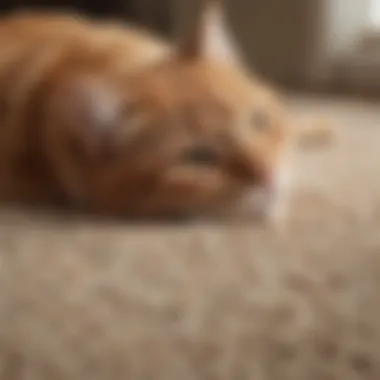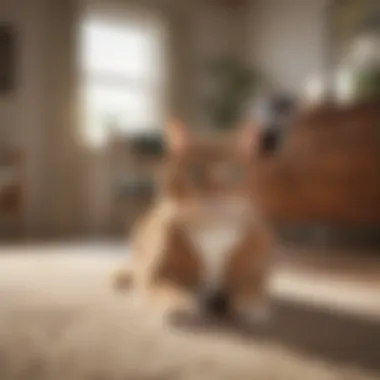The Ultimate Guide to Removing Cat Vomit Stains


Intro
Managing pet-related messes is an essential part of responsible pet ownership, particularly with cats. One common challenge cat owners face is cleaning up vomit stains. Understanding how to effectively remove these stains will assist in maintaining a clean and healthy environment for both pets and humans. In this guide, you'll discover methods and products that are effective in dealing with these stains and learn why being proactive about cleaning is vital.
Pet Care Essentials
Addressing cat vomit isn't solely about cleanliness; it ties directly into overall pet care. Keeping a clean home impacts your cat's health, comfort, and well-being. Here are crucial aspects of pet care that play a role in this topic:
Daily Nutrition Requirements
Proper nutrition is fundamental in preventing vomiting. Cats require a balanced diet rich in
- animal protein,
- essential fatty acids,
- vitamins, and minerals.
It’s important to select cat food that meets AAFCO specifications for complete nutrition. Consulting with a veterinarian regarding your cat's dietary needs can highlight potential problems early on, such as food allergies or sensitivities, which may lead to vomiting.
Exercise and Playtime
Regular play and physical activity can aid digestion. Engaging your cat in daily exercise serves multiple functions:
- Enriches their environment
- Reduces stress
- Encourages normal bowel movements
Increasing their activity reduces instances of bloating that can sometimes provoke vomit, addressing the root of the issue rather than just cleaning up afterward.
Grooming Tips
Furthermore, grooming often contributes significantly to overall health. Regular brushing decreases fur ingestion, which can often be a culprit for vomit in cats. Depending on their breed, establishing a grooming routine reduces matting and hairballs. It is essential to monitor their coat condition during cleanings as it may hint at dietary deficiencies or health problems.
Health and Wellness Check-ins
Routine vet check-ups become imperative in any discussion surrounding vomit. Established guidelines suggest annual check-ups for young cats and bi-annual visits for seniors. Through these visits, you can identify, prevent, or manage health concerns that may incite vomiting. Keeping track of health changes reinforces good management for still clean environments.
Understanding Stains and Cleaning Solutions
When it comes to cleaning cat vomit, knowledge is power. Understanding common household stains and effective cleaning solutions can alleviate some burden.
Composition of Stains
Different foods lead to varied vomit compositions. Fresh food may lead to easily managed stains. In contrast, burpy conditions, such as longer-kept foods or ingredients like fish, can lead to more persisting cleaning issues. Being aware of dietary routines will play a role in understanding the proper treatment required for particular stains too.
Effective Stain Remover Ingredients
Many cleaning products list natural enzymes or active ingredients capable of combating organic stains, such as:
- Hydrogen Peroxide: Effective in lifting protein stains but might color bleach genuine fabrics.
- Vinegar: Ideal for neutralizing odor and breaking down organic material.
- Baking Soda: Works well in conjunction with other cleaners for lifting stains generally.
- Commercial Pet-specific Products: Formulations created with delimiting agents engage effectively against unresolved stains. Brands offering enzyme cleaners can produce optimal results; talking to your veterinarian can direct you on which product is advisable.
Understanding Cat Vomit Stains
Understanding the nature of cat vomit stains is crucial for effectiveness in stain removal. Pet owners often encounter this situation not out of negligence, but as part of the reality of caring for a feline friend. Consequently, recognizing the components of vomit and the implications of instantaneous action can make a significant difference in managing these stains.
Composition of Cat Vomit
Cat vomit is primarily composed of undigested food, bile, and various types of hair. It can also contain liquid and proteins from the stomach. This distinct mixture can vary based on diet, health problems, or behavioral patterns. For instance, hairballs may be more pronounced in long-haired breeds, while a cat's dietary choices—whether dry, wet, or homemade—also affect vomit consistency. Because of these diverse components, pet parents must remain proactive in stain remediation.
Why Immediate Action is Necessary
Acting swiftly is essential when dealing with cat vomit stains. Leaving the stain unattended, even for a short duration, allows substances in the vomit to bond with the fibers of carpets or upholstery. This can lead to discoloration or long-term damage that becomes increasingly difficult to rectify. Moreover, some components, like bile, have corrosive properties, which can cause discoloration or persistent odors over time. From a sanitary perspective, swift intervention helps in maintaining hygiene and prevents the attraction of pests. Bein vigilant can protect both your environment and your pet’s health.


Addressing stains promptly is not just about keeping your space aesthetic; it also plays a role in preserving the health of your furry companions.
Factors Influencing Stain Removal
The removal of cat vomit stains is not a one-size-fits-all process. Several factors can impact how easily or effectively these stains are eradicated. Understanding these factors helps pet owners choose the right cleaning method and product, ensuring a cleaner and healthier environment. Grasping the nuances of how different elements interact with stains can significantly affect keeping your home pristine.
Type of Surface Affected
The nature of the surface where the stain appears plays a crucial role in determining the success of removal efforts. Different materials such as carpet, upholstery, hardwood, or tile require different approaches.
- Carpets and Upholstery: These porous surfaces can absorb vomit deeply, making it harder to clean. Enzymatic cleaners can be very effective here, as they break down the biological matter causing the stain.
- Hardwood Floors: On hardwood, immediate action is essential to prevent moisture from seeping in. Vinegar solutions should be used cautiously to avoid damage.
- Tiles/Grout: Tile is less absorptive, but vomit can still stain grout. Oxygen-based cleaners can help lift stains from these surfaces.
Important Considerations
- Always test your cleaner on a small area first to avoid damage.
- Water content can impact how the cleaner interacts; it is preferable to use a dabbing method than a scrubbing approach to prevent deeper penetration.
Age of the Stain
The time elapsed since the stain occurred greatly affects the likelihood of successful removal. Fresh stains are inherently easier to address, as the biological components have not geled or firmly adhered to the surface. In fact, immediate attention can mean the difference between effective clean up versus permanent setting.
- New Stains: The vomit stains are liquid, and basic blotting can often do miracles. Using the right cleaner will enhance effectiveness.
- Old Stains: As time passes, stains can become more embedded in materials. Sometimes, they lay dormant until something triggers their resurfacing, making removal much more challenging. Such situations might require more powerful cleaning solutions or methods like steam cleaning.
Strategy for Success
- Always tackle stains immediately.
- For aged stains, be prepared to use stronger products or dedicated techniques.
Ingredients in Cleaning Products
The type of ingredients in your chosen cleaning product is vital. Different formulations provide varying mechanisms for stain removal, and knowledge of these elements can dramatically increase efficacy.
- Enzymatic Cleaners: These are highly effective for biological stains because they contain enzymes that specifically break down proteins.
- Oxygen-Based Cleaners: These work by releasing oxygen, which helps to lift stains from surfaces without harsh chemicals.
- Vinegar and Baking Soda: Both ingredients are ubiquitous households cleaners, which can get quite effective when used properly and combined as foam.
Evaluating Safety and Effectiveness
- Read product labels carefully.
- Consider products free from harsh chemicals to ensure the safety of your pets in the home.
In summary, understanding the type of surface, the age of the stain, and the specific ingredients of cleaning products creates a informed approach to stain removal. By adapting techniques based on these factors, pet owners can ensure a cleaner and healthier living space, benefitting both household and feline friends.
Evaluating Stain Removers
To deal effectively with cat vomit stains, evaluating stain removers is essential. The performance of cleaning products is not uniform. Each product boasts different effectiveness based on their formulation. Understanding this helps pet owners select the optimal choice for their needs. When evaluating stain removers, important considerations include the type of stains, surfaces affected, and the ingredients in the cleaning solutions. Acolher evaluations help in making informed decisions, ensuring that cat vomit stains are removed efficiently.
Commercial Stain Removers
Commercial cleaning products often appear as the quickest solution to stubborn stains. These removers include specialized formulas designed to tackle a variety of messes. Usually containing enzymes, surfactants, and other chemicals, they aim to break down the organic matter in vomit. The enzymatic cleaners excel in this aspect as they target proteins in vomit that lead to stubborn stains and odor. Some top-rated commercial products are Nature's Miracle Stain and Odor Remover and Rocco & Roxie Professional Strength Stain and Odor Eliminator. These products not only remove stains, but also neutralize the odors caused by vomit.
However, safety is a contributing factor to consider. Not all cleaners are safe for pets, requiring pet owners to read reviews and verify labels.
Homemade Cleaning Solutions
Homemade solutions offer a more natural and often cost-effective alternative. Many common household ingredients can effectively tackle cat vomit stains successfully. These options are appealing for pet owners preferring to avoid harsh chemicals.
Common Household Ingredients
Baking soda, vinegar, and hydrogen peroxide rank among the highest in cleaning abilities. Each serves a specific purpose:
- Baking soda absorbs odors and acts as a gentle abrasive, making it an excellent tool for lifting stains.
- Vinegar, due to its acidic properties, helps break down proteins in vomit, making stains easier to remove.
- Hydrogen peroxide acts as a disinfectant and a stain remover effectively but can bleach fabrics, thus care is needed with fabric types.
The combination of these ingredients results in effective, safe, and eco-friendly stain removal.


Preparation and Application Techniques
When using homemade solutions, preparation matters as much as ingredients. The common approach is to mix white vinegar with equal parts of water. For heavy stains, it’s common to make a paste of baking soda mixed with water. Applying any cleaning solution effectively requires an appropriate procedure.
- Blot the stain immediately with a paper towel to remove excess vomit.
- Apply your chosen solution with a clean cloth or spray bottle.
- Let it sit for around 10-15 minutes to give it time to work on the stain.
- Rinse the area with water, blotting again until clean.
These steps balance efficiency and simplicity, ensuring that pet owners deal with stains effectively. Careful consideration of both containing efficacy and surface compatibility of ingredients ensures that cleaning leads to well-preserved household fabric and furnishings.
Top Commercial Products for Cat Vomit Remediation
In the effort to keep your home clean and odor-free, choosing the right commercial products for cat vomit remediation is essential. These products play a significant role in quickly addressing messes before they become permanent. Identifying the right solution helps not only in stain removal but also in reducing foul odors. When considering commercial products, evaluating their ingredients becomes critical as some substances may not be safe for your pets.
Enzymatic Cleaners
Enzymatic cleaners work by breaking down the proteins and fats present in cat vomit. This action makes them effective at odor elimination and stain removal. The active enzymes digest the organic matter, which sanitizes the area while ensuring any residues are lifted away. For absoute results, consider products such as Nature's Miracle and Rocco & Roxie.
When using enzymatic cleaners:
- Ensure that the product is suitable for multiples surfaces—carpet, tile, or wood.
- Apply liberally to thoroughly soaked areas, allowing the cleaner to dwell for the suggested time.
Utilizing enzymatic cleaners can be a strong choice for deep cleaning in homes with frequent pet issues.
Oxygen-Based Cleaners
Oxygen-based cleaners use active oxygen to lift stains and brighten surfaces. These products typically have bleaching effects, making them ideal not only for cat vomit but also for other stubborn stains. Brands like OxiClean offer formulation options that effectively target organic messes.
When applying oxygen-based cleaners:
- Dilute as mandadted to avoid surface damage.
- Use on colorfast fabrics to prevent discoloration.
Remember, since these are powerful cleaners, testing on a small, inconspicuous area beforehand is prudent.
Vinegar Solutions
Vinegar solutions are lesser-known yet effective options in cat vomit stain removal. Vinegar, being mildly acidi, can break down the components of urine, spit-up, or other pet’s messes without harsh chemicals. Combining white vinegar with water creates safe, eco-friendly cleaning solution.
To make a vinegar solution:
- Mix equal parts of white vinegar and water.
- Then pour it directly over the stain and scrub lightly.
It is vital to blot the area instead of rubbing to ensure the stain is not pushed further into the fabric.
Vinegar solutions are a wonderful alternative for those who aim to avoid chemical-laden products.
Step-by-Step Guide to Removing Cat Vomit Stains
Removing cat vomit stains requires a systematic approach to ensure both effectiveness and safety. Unlike some messes, vomit poses specific challenges due to its complex organic composition, which can lead to odors and discoloration if not treated properly and promptly. This guide not only provides clear, actionable steps but also emphasizes the significance of using appropriate methods suitable for various surfaces and materials. By following these instructions, pet owners can effectively maintain cleanliness in their environments and reduce the risk of recurring stains.
Preparation for Cleaning
Before initiating the cleaning process, it is essential to gather all necessary tools and materials. Preparation involves not only having the right supplies but also setting up the area to facilitate an efficient cleaning experience. Equip yourself with:
- Paper towels or a clean cloth for initial cleaning.
- A suitable stain remover, either commercial or homemade.
- A soft-bristle brush for deep cleaning, if needed.
- A bucket for mixture and rinsing if using a concentrated solution.
Begin by ensuring you have identified the location of the stain clearly. Remove any debris present without smearing it further. Pat the areas with paper towels to absorb as much of the liquid as possible.
Applying the Cleaning Solution
After preparing the area, it is time to apply your chosen cleaning solution. Depending on your selected method, follow these guiding principles. If utilizing a commercial stain remover or an enzymatic cleaner, apply the solution directly onto the specified area. Be sure to follow the manufacturer's guidelines for the best effectiveness.


If you choose a homemade mixture like a baking soda and vinegar blend:
- Combine equal parts of baking soda and vinegar in a bowl to form a paste.
- Apply this paste directly over the stain, ensuring it covers the affected area completely.
- Give it some time—let the solution sit for about 5 to 10 minutes to allow the ingredients to penetrate.
For textured surfaces or carpets, gently work the solution into the fibers using a soft-bristle brush in circular motions. Avoid excessive scrubbing, as this may cause more damage.
Drying and Final Touches
Once the cleaning solution has worked to lift the stain, drying is the next vital phase. Use clean paper towels or dry cloths to blot the residual moisture from the area. Avoid rubbing, as this could risk further embedding the remnants into the fabric. If the location is small, using fans or open windows can help facilitate quicker drying.
For an added touch, once the stained area is dry:
- Inspect for any remaining odors. A light sprinkle of baking soda on the dried spot can help absorb persistent smells. Leave the soda on overnight before vacuuming it off.
- Lastly, check if any stain remains. If necessary, repeat the application of the cleaning solution following the previous steps until the area appears clean and odor-free.
Following this systematic guide enables every pet owner to address the cleanliness of their home in an effective manner. Making efforts at each stage maximizes outcome and protects the belongings further.
Safety Precautions
When dealing with cat vomit stains, safety precautions are vital. Cat vomit can contain harmful bacteria and pathogens. It is necessary to be careful when handling this type of mess. Additionally, many cleaning products may have ingredients that are toxic to pets. Knowing how to evaluate products that are safe is essential in protecting your animals.
Evaluating Product Safety for Pets
Evaluating product safety requires a thorough assessment of the ingredients in cleaning solutions. Not all products are safe for pets. Many commercial cleaners could harm a cat if ingested or inhaled. It's best to look for products labeled as pet-friendly or non-toxic. These products have undergone safety testing that ensures they do not pose a risk to your pets.
When considering a specific cleaner, read the label carefully. Look for warnings and ingredient lists. If there's any ambiguity, it might help to search for reviews about the product. Users often share insights about their experiences, providing clarity on the product’s safety.
Additionally, consider using enzymatic cleaners. These types of products often utilize natural enzymes that digest organic stains. Such cleaners can be effective without the added risk of harmful chemicals.
Handling Stains While Protecting Surfaces
Handling stains properly without damaging surfaces dictates the choice of cleaning method. Some surfaces may react adversely to certain cleaning agents. Carpets, for example, can lighten with specific chemicals or become discolored.
To avoid this, test the cleaning solution on a small, hidden area first. This patch test helps ensure there will be no adverse reactions before applying the product to the visible stain. Always follow the manufacturer’s instructions to use the cleaners properly and safely.
Even when using naturally derived products, caution is necessary. Substances like vinegar can have strong effects on certain fabrics or wood finishes. Employ gentle cleaning methods, like blotting instead of scrubbing, to protect surfaces while effectively removing the stain.
Remember, keeping your pets safe while maintaining a clean environment is possible with careful choice and use of cleaning products.
Preventative Measures for Cat Vomit
Keeping a clean home is not just about reaction but also prevention. Effective strategies can help to minimize instances of cat vomiting. Not only do preventative measures reduce the frequency of these unpleasant occurrences, but they can also lead to a more healthy environment for both pets and their owners. Veterinary consultations regarding your cat’s diet and routine can be highly beneficial. Below are key strategies that pet owners should consider.
Dietary Considerations
One primary factor that influences vomiting in cats is their diet. It is crucial to feed your cat a well-balanced and high-quality diet suited to its age, weight, and health status. Here are some significant dietary aspects to consider:
- High-Quality Protein: Cats are obligate carnivores, meaning they thrive on protein-based diets. Ensure that any feed includes specific protein sources, especially from meats.
- Manage Portions: Overeating can lead to gastrointestinal distress, triggering vomit. Measure out servings and avoid free-feeding. Consider feeding smaller meals more frequently throughout the day.
- Avoid Sudden Changes: A cat's digestive system is sensitive. When switching diets, it is imperative to gradually transition to new food to help reduce potential stomach upset.
- Hydration: Ensure your cat has access to fresh water. Proper hydration supports a more effective digestive system and prevents potential health problems.
In summary, paying attention to dietary factors can mitigate the likelihood of vomiting. Adjusting food and feeding practices can play a significant role in preventing vomit incidents.
Regular Health Check-Ups
Regular veterinary check-ups serve as an excellent risk management strategy. They not only enhance your pet’s quality of life but also promote preventive health measures. Here’s how consistent veterinary visits help:
- Early Detection of Health Issues: Cats may show signs of illness subtly. Regular check-ups allow for prompting detection of issues that could potentially cause vomiting, like infections or digestive disorders.
- Vaccines & Parasite Control: Keeping cat vaccines up-to-date can prevent myriad health risks. Parasite control, too, is key in addressing potential causes of vomiting like intestinal worms.
- Nutritional Guidance: Vets can offer insights into diet. They help you find optimal nutrition for your cat based on age, weight and health needs, reducing the probability of digestive upset.
- Dental Health: Bad dental hygiene might affect overall health and digestion. Regular vet visits ensure your cat's dental needs are also met, leading to overall health improvements.
Closure
In this article, we have examined the intricate issues surrounding the removal of cat vomit stains from various surfaces. Addressing stains caused by our feline companions means more than just maintaining cleanliness; it directly affects the hygiene and comfort of our homes. The discussion emphasizes the need for prompt action when cleaning, considering the unique composition of cat vomit which can include proteins and food particles.
Understanding why specific stain removers work or fail is essential. Pet owners should choose appropriate cleaning agents based on factors like their surface types and ingredient efficacy. In turn, these decisions influence whether stains persist or are completely gone. Ultimately, using quality products aidsin avoiding permanent damage to surfaces and allows one to sustain an aesthetically pleasing living environment.
Moreover, employing preventative measures, such as dietary modifications or routine health vet visits, can significantly reduce the likelihood of future incidents. Awareness not only leads to fewer stains but provides peace of mind for both the owner and the pet. As highlighted, integrating these insights ensures that being a pet owner is a positive experience, impacting overall pet welfare and the owner's quality of life.
As we conclude this guide on the best stain removal practices, it is clear that understanding the right approaches to effectively wipe away cat vomit can foster both a cleaner home and better relationships with our furry friends. Maintaining an environment free from such messes ultimately contributes to a happier life for every household, highlighting the vivid connection between animal care and human living spaces.







